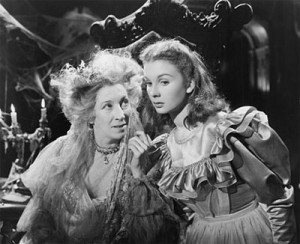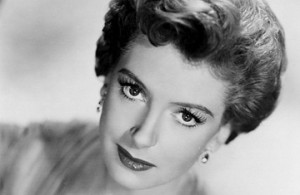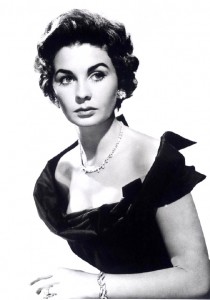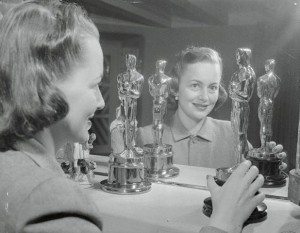Of these four ladies, Deborah Kerr, in her forty-five years of movie-making, had the highest percentage of exceptional roles and films, beginning with most of her pre-American British flicks. The most outstanding is Black Narcissus, an Oscar winner for Jack Cardiff’s sumptuous color cinematography. Kerr’s role of a nun would be reprised in John Huston’s Heaven Knows, Mr. Allison ten years later.
The Hucksters in 1947 killed two birds with one stone—Clark Gable’s first film after his WWII service and Deborah’s American début. There was little magic between the two stars, perhaps the distracting allure of Ava Gardner a contributing factor. (Ava’s exquisite physical beauty would alone qualify her as a possible fifth lady in this group were it not for that earthy eroticism that she found difficult to suppress.) Sydney Greenstreet steals the show as head of a soap company, and Gable dumping a pitcher of water on his head is the highlight of the picture.
Deborah maintained her famous well-bred persona—and the best coiffure in the movies—even when cast as a character with a dark secret or a critical flaw, or, sometimes, brought down from her pedestal by a man less well-bred. In From Here to Eternity she’s an Army officer’s wife having an affair with an enlisted man—she and Burt Lancaster enfolded in the surf, remember? In Tea and Sympathy she tutors a young man—a boy in the original play, though John Kerr (no relation) is twenty-five—in the ways of love. By contrast, in Separate Tables she’s a mousy virgin too intimidated by relationships of any kind to even say the word “sex.” [See the separate review of Separate Tables.]
With her aged grandfather as her only companion, in The Night of the Iguana she’s a spinster, coincidentally starring with Ava. Her idea of a “sexual experience” is allowing an Aussie underwear salesman to hold a piece of her clothing, providing she looks the other way. As a woman fresh out of prison, in The Chalk Garden, a personal favorite, she tutors a wild teenage girl whose lying and fantasies reflect her own tragic failings as a youngster. Fitting atmosphere is provided by Malcolm Arnold’s subtle score, one of his best, though rarely praised, even acknowledged.
Besides these “traditional” roles—traditional for her—Deborah proves herself in a Western, Australian style, The Sundowners; a musical, The King and I, in which Marni Nixon dubbed her singing voice; a Biblical epic, though the slow-moving, talkie Quo Vadis? [See the separate review of Quo Vadis? on BD Quo Vadis?]seriously tests the patience; and a particularly well done, subtle supernatural exercise, The Innocents, based on Henry James’ The Turn of the Screw. Even one of her few excursions into comedy, Prudence and the Pill, proved reasonably satisfactory.
One of Deborah’s co-stars in Black Narcissus, Young Bess and The Grass Is Greener is Jean Simmons, the fourth of these lovely ladies, in some ways the most sublimely beautiful—pristine, shimmering. As film scholar David Thomson has astutely observed, “ . . . she was a valued actress whose generally proper, if not patrician, manner had an intriguing way of conflicting with her large, saucy eyes and a mouth that began to turn up at the corners as she imagined mischief . . . ”
Right off, it must be admitted that among this distinguished quartet of beauties, Jean has the lowest percentage of first-class films. Leslie Halliwell said it best: she “ . . . settled in Hollywood to make films which have generally been unworthy of her talents.”
Jean’s early British films, however, are as impressive as any actress could wish, including Black Narcissus, Olivier’s Hamlet, The Blue Lagoon, even the chiller Uncle Silas (do investigate the superb score on Chandos’ Rawsthorne film music compilation), but of these films, for anyone who has seen it, the most indelible in memory is Great Expectations of 1946, based on the Charles Dickens novel.
One of the all-time greats, though inexplicably neglected, the film is perhaps director David Lean’s greatest effort, before he came down with gargantulitus, i.e., Lawrence of Arabia and Doctor Zhivago. Great Expectations has a Hollywood polish—here intended as a compliment—with a craftsmanship and detail reflected, not only in the direction but in Guy Green’s photography and John Byran’s production design.
Oscar nominated for Picture, Director, Adapted Screenplay, B&W Cinematography and B&W Art/Set Decoration, it won for the last two; that same year, Black Narcissus won its own two Oscars, same last two categories, only for color. Jean, in fact, accepted the four awards for these British, Arthur Rank productions at the Oscar ceremony, March 20, 1948.
Great Expectations is resplendent with memorable scenes—the justly famous meeting, in the cemetery, between young Pip (Anthony Wager) and the convict Magwitch (Finlay Currie); Pip’s first arrival at the old Havisham mansion and, from the window, young Estella’s (Jean) first line, “What name?”; the introduction of Miss Havisham (Martita Hunt), as Pip opens her door and enters; the both mysterious and frightening return of Magwitch to the mature Pip (John Mills) during a stormy night; and the death of Miss Havisham, her gown engulfed in flames from a dislodged log from her fireplace.
Jean is seen only in the early part of the film; the mature Estella is continued by Valerie Hobson. However brief, there is something about Jean’s performance which catches in the memory. Her girlish attire and beauty contrasted with her cruel treatment of the young Pip—“You stupid, clumsy, laboring boy,” she calls him—is far more acute and convincing than Hobson’s coldness toward the man who has confessed he has loved her since that first day at Miss Havisham’s.
 Another exceptional aspect of the film is Walter Goehr’s score, on a par with the photography, sets and direction. The German-born composer and student of Arnold Schoenberg came to Britain in 1932 as music director of what would later be renamed EMI. To cite only one magical sequence, a strident trumpet heralds Pip’s first visit to Miss Havisham’s, then a five-note motif for Estella as she arrives to open the gate. As Pip follows the girl through the house and up the stairs, lively strings alternate with chirping woodwinds, followed by first pulsating, then pizzicato strings—kinetic music of anticipation beneath a visual aura of uncertain gloom.
Another exceptional aspect of the film is Walter Goehr’s score, on a par with the photography, sets and direction. The German-born composer and student of Arnold Schoenberg came to Britain in 1932 as music director of what would later be renamed EMI. To cite only one magical sequence, a strident trumpet heralds Pip’s first visit to Miss Havisham’s, then a five-note motif for Estella as she arrives to open the gate. As Pip follows the girl through the house and up the stairs, lively strings alternate with chirping woodwinds, followed by first pulsating, then pizzicato strings—kinetic music of anticipation beneath a visual aura of uncertain gloom.
Please excuse the extended time spent on Great Expectations: it is one of my Top Ten films.
Stewart Granger was Jean’s first husband, and they made a number of films together. The couple being married at the time adds a presumed realism to their romantic scenes. She first starred with him in the British version of Caesar and Cleopatra (1945), based on Shaw’s play, not to be confused with the much superior American Cleopatra (1932), with Claudette Colbert. Young Bess is essentially about Elizabeth I (Jean) before she became queen. Charles Laughton has a second go as Henry VIII , and Granger, as an early suitor of Elizabeth, goes to the block. The music is by none other than Miklós Rózsa.
Two years later they starred together in Footsteps in the Fog, a Victorian drama—recalling, perhaps, Uncle Silas—about a maid (Jean) who knows her master poisoned his wife and blackmails him for a job promotion and a romantic attachment. Stephen Lowry (Granger) schemes to incriminate her by taking just enough poison, he figures, to be saved when the doctor arrives. He sends her for the doctor, but she is delayed at the police station and the physician arrives too late.
In The Big Country, retired sea captain Gregory Peck arrives out West to marry his fiancée (Carroll Baker) and is quickly derided for his dude ways, makes enemies and becomes involved in a range feud. As a subplot, he meets a young miss (Jean), who is fascinatingly different from his fiancée. He has to choose between them—and makes the same decision I would make were I in his shoes: he rides off into the sunset with Jean.
In films before and after The Big Country, she acted opposite Spencer Tracy in The Actress, Marlon Brando and Frank Sinatra in Guys and Dolls, Cary Grant and Robert Mitchum in The Grass Is Greener and Kirk Douglas in Spartacus.
In one of her best roles as a hellfire evangelist, Jean stars with Burt Lancaster and Shirley Jones in Elmer Gantry. Lancaster won a Best Actor Oscar for being Burt Lancaster, toothy smile and all. Shirley, a heretofore goody-goody girl in musicals and another runner-up for my four ladies, gained Best Supporting Actress for her change-of-image role as a prostitute. Jean, in an equally disparate role, was not even nominated; she was clearly better that year than Elizabeth Taylor, who won for Butterfield 8, mostly out of sympathy for her recent illness and for those unsuccessful nominations the previous three years.
Throughout her career, Jean would receive two Oscar nominations—a Best Supporting for Hamlet (1948) and Best Actress for The Happy Ending (1969), directed by her second husband Richard Brooks.
In 1989, Jean had, in a sense, come full circle in a TV mini-series of Great Expectations, now convincingly cast as Miss Havisham, forty-three years having passed since her Estella role. As so often in her career, she has admirable support: Anthony Hopkins as Magwitch, John Rhys-Davies as Joe Gargery and Anthony Calf as the mature Pip. This version, please note, should not be confused with the 1998 theatrical movie, starring Ethan Hawke, Gwyneth Paltrow and Robert De Niro, with Anne Bancroft as a ghastly played Miss Havisham. The whole enterprise is a travesty of Dickens, to be avoided.
——————— * ———————-
So there, four lovely ladies. Sure, there are other actresses with equally wholesome images—Maureen O’Hara, Greer Garson, Audrey Hepburn, Myrna Loy and Shirley Jones. They’re just not among my top four. And, too, there are other ladies possibly as beautiful as those I’ve selected—Elizabeth Taylor, Kim Novak, Grace Kelly, Lana Turner, Catherine Deneuve, Sophia Loren, Greta Garbo and Ava Gardner—but their images are most often erotic and sultry, earthy and, that word again, licentious.
Olivia, Ingrid, Deborah and Jean. Ingrid and Jean worked until the end of their careers, Deborah was ill the last years of her life and Olivia has retired; she hasn’t made a film—and then it was for TV—since 1988. I couldn’t—wouldn’t—choose the favorite of the four, nor name the one I’d most miss from the movies if, somehow, their screen images were lost forever.



classic movies are always source of inspiration for everyone ……….